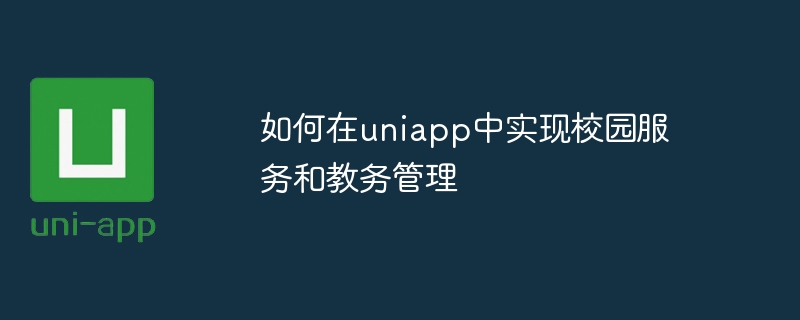 Web Front-end
Web Front-end
 uni-app
uni-app
 How to implement campus services and academic affairs management in uniapp
How to implement campus services and academic affairs management in uniapp
How to implement campus services and academic affairs management in uniapp
Oct 27, 2023 pm 12:57 PM
How to implement campus services and academic affairs management in uniapp
With the development of mobile Internet, campus services and academic affairs management systems have become important needs of schools and students. As a cross-platform development framework, uniapp can quickly and easily develop campus service and educational management applications that meet different platforms. This article will introduce how to implement campus services and academic affairs management in uniapp, and give some specific code examples.
1. Campus Services
Campus services are an important part of students' lives, including course schedules, score inquiries, library borrowing, campus news and other functions. Here are some code examples:
1. Course schedule
uniapp provides vue syntax, which can easily realize dynamic rendering of course schedule. Obtain the student's course information through the interface, convert the course schedule data into a two-dimensional array, and then use the v-for instruction to traverse the array to generate the course schedule. Code example:
<template>
<view>
<table>
<tr v-for="(row, index) in timetable" :key="index">
<td v-for="(course, rowIndex) in row" :key="rowIndex">{{ course }}</td>
</tr>
</table>
</view>
</template>
<script>
export default {
data() {
return {
timetable: [
["", "", "语文", "数学", "", ""],
["", "", "英语", "", "数学", ""],
// 其他时间段的课程数据
]
}
}
}
</script>2. Score query
The score query function needs to obtain the student's score information through the interface and display the score data on the page. Code example:
<template>
<view>
<ul>
<li v-for="(score, index) in scores" :key="index">
{{ score.course }}: {{ score.score }}
</li>
</ul>
</view>
</template>
<script>
export default {
data() {
return {
scores: [
{ course: "语文", score: 90 },
{ course: "数学", score: 95 },
// 其他课程的成绩数据
]
}
}
}
</script>2. Educational Affairs Management
Educational administration management includes student information management, course management, teacher management and other functions. Here are some code examples:
1. Student information management
Student information management needs to implement functions such as student list display, adding students, and deleting students. Code example:
<template>
<view>
<ul>
<li v-for="(student, index) in students" :key="index">
{{ student.name }}
<button @click="deleteStudent(index)">删除</button>
</li>
</ul>
<input v-model="newStudentName" type="text" placeholder="请输入姓名">
<button @click="addStudent">添加学生</button>
</view>
</template>
<script>
export default {
data() {
return {
students: [
{ name: "张三" },
{ name: "李四" },
// 其他学生信息
],
newStudentName: ''
}
},
methods: {
addStudent() {
this.students.push({name: this.newStudentName})
this.newStudentName = ''
},
deleteStudent(index) {
this.students.splice(index, 1)
}
}
}
</script>2. Course management
Course management needs to realize the functions of displaying course list, editing courses, deleting courses, etc. Code example:
<template>
<view>
<ul>
<li v-for="(course, index) in courses" :key="index">
{{ course.name }}
<button @click="editCourse(index)">编辑</button>
<button @click="deleteCourse(index)">删除</button>
</li>
</ul>
</view>
</template>
<script>
export default {
data() {
return {
courses: [
{ name: "语文" },
{ name: "数学" },
// 其他课程信息
]
}
},
methods: {
editCourse(index) {
// 跳转到课程编辑页面,传递课程信息给编辑页面
uni.navigateTo({
url: '/pages/course/edit?id=' + index
})
},
deleteCourse(index) {
this.courses.splice(index, 1)
}
}
}
</script>In summary, campus services and academic affairs management systems can be easily implemented through uniapp. This article gives some specific code examples, hoping to help developers implement campus services and academic affairs management in uniapp. Of course, since specific project requirements vary, developers need to make appropriate modifications and expansions based on actual conditions.
The above is the detailed content of How to implement campus services and academic affairs management in uniapp. For more information, please follow other related articles on the PHP Chinese website!

Hot Article

Hot tools Tags

Hot Article

Hot Article Tags

Notepad++7.3.1
Easy-to-use and free code editor

SublimeText3 Chinese version
Chinese version, very easy to use

Zend Studio 13.0.1
Powerful PHP integrated development environment

Dreamweaver CS6
Visual web development tools

SublimeText3 Mac version
God-level code editing software (SublimeText3)

Hot Topics
 How do I handle local storage in uni-app?
Mar 11, 2025 pm 07:12 PM
How do I handle local storage in uni-app?
Mar 11, 2025 pm 07:12 PM
How do I handle local storage in uni-app?
 How do I use uni-app's geolocation APIs?
Mar 11, 2025 pm 07:14 PM
How do I use uni-app's geolocation APIs?
Mar 11, 2025 pm 07:14 PM
How do I use uni-app's geolocation APIs?
 How do I manage state in uni-app using Vuex or Pinia?
Mar 11, 2025 pm 07:08 PM
How do I manage state in uni-app using Vuex or Pinia?
Mar 11, 2025 pm 07:08 PM
How do I manage state in uni-app using Vuex or Pinia?
 How do I make API requests and handle data in uni-app?
Mar 11, 2025 pm 07:09 PM
How do I make API requests and handle data in uni-app?
Mar 11, 2025 pm 07:09 PM
How do I make API requests and handle data in uni-app?
 How do I use uni-app's social sharing APIs?
Mar 13, 2025 pm 06:30 PM
How do I use uni-app's social sharing APIs?
Mar 13, 2025 pm 06:30 PM
How do I use uni-app's social sharing APIs?
 How to handle file encoding with UniApp download
Mar 04, 2025 pm 03:32 PM
How to handle file encoding with UniApp download
Mar 04, 2025 pm 03:32 PM
How to handle file encoding with UniApp download
 How do I use preprocessors (Sass, Less) with uni-app?
Mar 18, 2025 pm 12:20 PM
How do I use preprocessors (Sass, Less) with uni-app?
Mar 18, 2025 pm 12:20 PM
How do I use preprocessors (Sass, Less) with uni-app?







